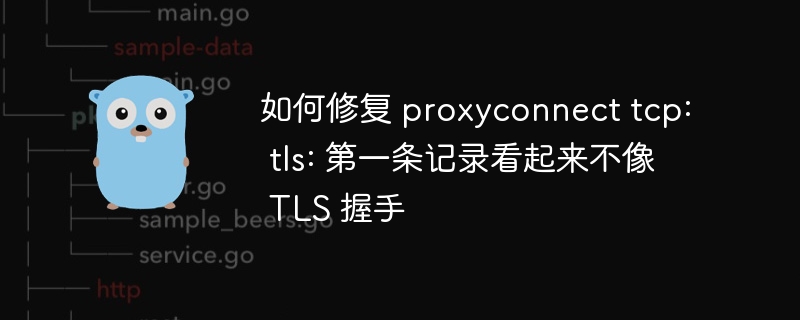
php小编苹果在这里为大家带来解决"proxyconnect tcp: tls: 第一条记录看起来不像 TLS 握手"问题的方法。这种错误通常出现在使用代理服务器时,可能会导致网络连接问题。在解决此问题之前,我们首先需要了解问题的根源。通过以下简明的步骤,我们将向您展示如何修复这个问题,以确保您的网络连接正常运行。
问题内容
在如何在 Go 中使用 REST API 中,提供了一个完全有效的示例代码来调用公共 REST API。但如果我尝试示例,则会出现此错误:
error getting cat fact:
Get "https://catfact.ninja/fact":
proxyconnect tcp: tls: first record does not look like a TLS handshake有关http状态的文档
For control over proxies, TLS configuration, keep-alives, compression, and other settings, create a Transport:
以及传输文档:
// DialContext specifies the dial function for creating unencrypted TCP connections.
// If DialContext is nil (and the deprecated Dial below is also nil),
// then the transport dials using package net.
//
// DialContext runs concurrently with calls to RoundTrip.
// A RoundTrip call that initiates a dial may end up using
// a connection dialed previously when the earlier connection
// becomes idle before the later DialContext completes.
DialContext func(ctx context.Context, network, addr string) (net.Conn, error)
因此,我假设我必须配置 Dialcontext 才能启用从客户端到代理的不安全连接 without TLS。但我不知道该怎么做。阅读这些:
- 如何在golang中进行代理和TLS;
- 如何通过代理进行 HTTP/HTTPS GET;和
- 如何使用错误的证书执行 https 请求?
也没有帮助。有些有同样的错误 proxyconnect tcp: tls:first record does not Look like a TLS handshake 并解释原因:
This is because the proxy answers with an plain HTTP error to the strange HTTP request (which is actually the start of the TLS handshake).
但是Steffen的回复没有示例代码如何设置DialContext func(ctx context.Context, network, addr string),Bogdan和cyberdelia都建议设置tls.Config{InsecureSkipVerify: true},例如这样< /p>
tr := &http.Transport{
TLSClientConfig: &tls.Config{InsecureSkipVerify: true},
}
client := &http.Client{Transport: tr}
但是上面的没有效果。我仍然遇到同样的错误。并且连接仍然调用 https://* 而不是 http://*
这是示例代码,我尝试包含上述建议并对其进行调整:
var tr = &http.Transport{ TLSClientConfig:
&tls.Config{InsecureSkipVerify: true}, }
// lacks DialContext config
var client* http.Client = &http.Client{Transport: tr} // modified * added
// var client *http.Client // code from tutorial
type CatFact struct {
Fact string `json:"fact"`
Length int `json:"length"`
}
func GetCatFact() {
url := "http://catfact.ninja/fact" // changed from https to http
var catFact CatFact
err := GetJson(url, &catFact)
if err != nil {
fmt.Printf("error getting cat fact: %sn", err.Error())
} else {
fmt.Printf("A super interesting Cat Fact: %sn", catFact.Fact)
}
}
func main() {
client = &http.Client{Timeout: 10 * time.Second}
GetCatFact()
// same error
// proxyconnect tcp: tls: first record does
// not look like a TLS handshake
// still uses https
// for GET catfact.ninja
}
如何将连接配置为使用从 myClient 通过代理到服务器的未加密连接?设置 DialContext func(ctx context.Context, network, addr string) 有助于做到这一点吗?怎么办?
解决方法
我刚刚尝试过:
package main
import (
"context"
"crypto/tls"
"encoding/json"
"fmt"
"net"
"net/http"
"time"
)
type CatFact struct {
Fact string `json:"fact"`
Length int `json:"length"`
}
// Custom dialing function to handle connections
func customDialContext(ctx context.Context, network, addr string) (net.Conn, error) {
conn, err := net.Dial(network, addr)
return conn, err
}
// Function to get a cat fact
func GetCatFact(client *http.Client) {
url := "https://catfact.ninja/fact" // Reverted back to https
var catFact CatFact
err := GetJson(url, &catFact, client)
if err != nil {
fmt.Printf("error getting cat fact: %sn", err.Error())
} else {
fmt.Printf("A super interesting Cat Fact: %sn", catFact.Fact)
}
}
// Function to send a GET request and decode the JSON response
func GetJson(url string, target interface{}, client *http.Client) error {
resp, err := client.Get(url)
if err != nil {
return fmt.Errorf("error sending GET request: %w", err)
}
defer resp.Body.Close()
if resp.StatusCode != http.StatusOK {
return fmt.Errorf("received non-OK HTTP status: %d", resp.StatusCode)
}
err = json.NewDecoder(resp.Body).Decode(target)
if err != nil {
return fmt.Errorf("error decoding JSON response: %w", err)
}
return nil
}
func main() {
// Create a custom Transport with the desired settings
tr := &http.Transport{
Proxy: http.ProxyFromEnvironment, // Use the proxy settings from the environment
DialContext: customDialContext, // Use the custom dialing function
TLSClientConfig: &tls.Config{
InsecureSkipVerify: true, // Skip certificate verification (not recommended in production)
},
}
// Create a new HTTP client using the custom Transport
client := &http.Client{
Transport: tr,
Timeout: 10 * time.Second,
}
// Call the function to get a cat fact
GetCatFact(client)
}
它包括:
自定义拨号函数
customDialContext:
该函数目前是net.Dial的简单包装,但它提供了一个可以在必要时引入自定义拨号逻辑的位置。它用作自定义拨号功能,用于创建网络连接。传输配置:
- 修改后的代码使用特定设置配置自定义
http.Transport,包括自定义拨号功能、环境中的代理设置以及跳过证书验证的 TLS 配置(用于测试)。 - 原始代码还尝试配置自定义
http.Transport,但仅包含跳过证书验证的TLS配置,并没有设置自定义拨号功能或代理设置。
- 修改后的代码使用特定设置配置自定义
客户端配置:
- 修改后的代码使用自定义的
http.Transport创建新的http.Client,并设置超时为 10 秒。 - 原始代码还尝试使用自定义
http.Transport创建新的http.Client,但后来在main函数中,它使用新的http.Client覆盖了client变量,其中包含默认的Transport和超时10秒的,有效丢弃自定义的Transport。
- 修改后的代码使用自定义的
函数签名:
- 修改后的代码修改了
GetCatFact和GetJson函数以接受*http.Client参数,允许它们使用在main中创建的自定义http.Client。 - 原始代码没有将
http.Client传递给这些函数,因此它们将使用net/http包提供的默认http.Client。
- 修改后的代码修改了
网址:
- 修改后的代码将
GetCatFact函数中的 URL 恢复为“https://catfact.ninja/fact”,因为服务器无论如何都会将 HTTP 请求重定向到 HTTPS。 - 原始代码已将 URL 更改为“http://catfact.ninja/fact”,以避免 TLS 握手错误。
- 修改后的代码将
上面提供的代码中的 customDialContext 函数不包含任何专门忽略 TLS 握手错误或将 TLS 握手更改为非 TLS 连接的逻辑。它只提供了自定义拨号功能,在提供的形式中,直接调用net.Dial,无需任何特殊处理。
忽略TLS证书验证错误的机制实际上是由http.Transport结构体的TLSClientConfig字段提供的,具体是将InsecureSkipVerify字段设置为true:
tr := &http.Transport{
TLSClientConfig: &tls.Config{InsecureSkipVerify: true},
}
client := &http.Client{Transport: tr}
该配置告诉 Go 跳过验证服务器的证书链和主机名,这是 TLS 握手过程的一部分。但是,它不会忽略其他类型的 TLS 握手错误或切换到非 TLS 连接。通常不建议在生产环境中使用 InsecureSkipVerify: true,因为它会禁用重要的安全检查。
如果您想强制使用非 TLS(纯 HTTP)连接,通常只需使用 http:// URL,而不是 https:// URL。但是,如果服务器或代理服务器将 HTTP 重定向到 HTTPS(例如 http://catfact.ninja/fact 的情况),则客户端将遵循重定向并切换到 TLS 连接。



